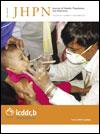Community-based Health Workers Achieve High Coverage in Neonatal Intervention Trials: A Case Study from Sylhet, Bangladesh
DOI:
https://doi.org/10.3329/jhpn.v28i6.6610Keywords:
Chlorhexidine, Cluster-randomized trial, Community-based studies, Community health workers, Interventions, Neonatal health, Umbilical cord cleansing, BangladeshAbstract
A large proportion of four million neonatal deaths occur each year during the first 24 hours of life. Research is particularly needed to determine the efficacy of interventions during the first 24 hours. Large cadres of community-based workers are required in newborn-care research both to deliver these interventions in a standardized manner in the home and to measure the outcomes of the study. In a large-scale community-based efficacy trial of chlorhexidine for cleansing the cord in north-eastern rural Bangladesh, a two-tiered system of community-based workers was established to deliver a package of essential maternal and newborn-care interventions and one of three umbilical cord-care regimens. At any given time, the trial employed approximately 133 community health workers—each responsible for 4-5 village health workers and a population of approximately 4,000. Over the entire trial period, 29,760 neonates were enrolled, and 87% of them received the intervention (their assigned cord-care regimen) within 24 hours of birth. Approaches to recruitment, training, and supervision in the study are described. Key lessons included the importance of supportive processes for community-based workers, including a strong training and field supervisory system, community acceptance of the study, consideration of the setting, study objectives, and human resources available.Key words: Chlorhexidine; Cluster-randomized trial; Community-based studies; Community health workers; Interventions; Neonatal health; Umbilical cord cleansing; Bangladesh
DOI: 10.3329/jhpn.v28i6.6610
J HEALTH POPUL NUTR 2010 Dec;28(6):610-618
Downloads
Download data is not yet available.
Abstract
269
269
PDF
214
214
Downloads
How to Cite
Shah, R., Munos, M. K., Winch, P. J., Mullany, L. C., Mannan, I., Rahman, S. M., … Baqui, A. H. (2010). Community-based Health Workers Achieve High Coverage in Neonatal Intervention Trials: A Case Study from Sylhet, Bangladesh. Journal of Health, Population and Nutrition, 28(6), 610–618. https://doi.org/10.3329/jhpn.v28i6.6610
Issue
Section
Original Papers

